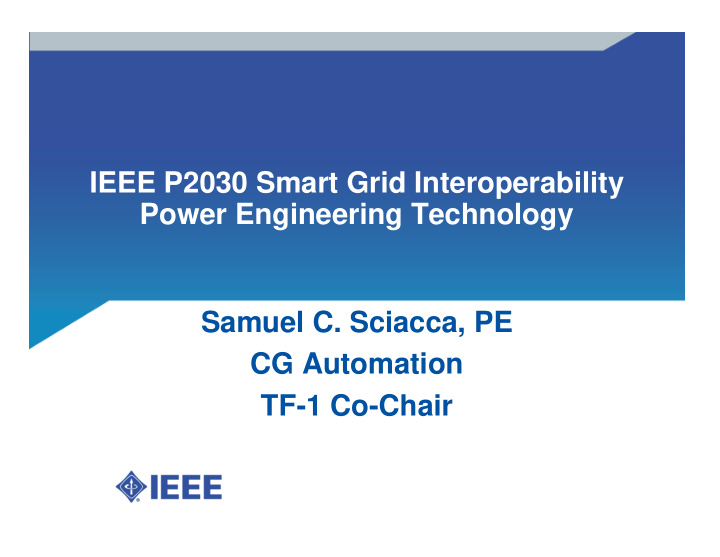



IEEE P2030 Smart Grid Interoperability Power Engineering Technology Samuel C. Sciacca, PE CG Automation TF-1 Co-Chair
P2030 Overall Goals �� ���������������������������������������������������������������������������� ���������������������������������������������������������������� �� ������������������������������������������������������������� ������������������������� �� ������������������������������������������������������������������������� �������������������������������������������������������������������� �� ����������������������������������������������������������������������� ������������������ �� ��������������������������������������������������������������� ��������� ������������������������������������������������ �� ������������������������������������������������������������������������� �����������������������������������������������������������������������
Three Task Forces Formed to Lead the Effort TF-1 Power Engineering Technology – Power and Energy Society Centric – Focusing on definition of the needs TF-2 Information Technology – IEEE Computer Society Centric TF-3 Communications – IEEE Communications Society Centric Unprecedented collaboration of three IEEE Societies Approximately 150 participants, evenly divided in the three Task Forces. Some common membership.
TF-1 Consensus of Direction TF-1 will focus on functional requirements of interoperability Draw as much as possible from existing/concurrent efforts of others (PES, ISA, GWAC, SGIP) Proactively Outreach for input/participation (e.g. EEI, NARUC, NEMA, IEC) Realtime Collaboration with TF-2 and TF-3 essential to every aspect of our effort Break from traditional thinking to “future-proof” the efforts Solutions must accommodate existing infrastructure (e.g., 80,000 – 90,000 existing substations)
TF-2 and TF-3 Take the requirements developed by TF-1 and develop interoperability guidelines for: – Protocol – Architecture – Transport – Application – Security – Privacy – et. al
7
8
Today, every blue line you see is custom-developed on a per utility, per entity basis! P2030 will attempt to uniformly define these elements to achieve interoperability 9
The Devil’s in the Details! What data set? What accuracies? What periodicity? What data rates? What protocol? Client, Server, or both? Polled or Unsolicited? Multiple clients? Remote Instruction/Control? Dispatachable?
Request for Customer to Reduce Load # of Amps, # of Kilowatts, Percentage of load? Instantaneous Daily Average Monthly Average When: Now; 4 hours from now? For How Long: One hour, One Day, Indefinitely? Opt Out: Instantaneous, 5 minute excursion, 15 minute excursion?
Possible Model Refinement What adjustments should we consider for: – Individual Utilities – Independent System Operators – Aggregators What cloud sub-categories should we consider? Example: Customer – Residential – Industrial – Industrial with substation – Customer with generation
Power Engineering Technology Divided into 6 Sub Tasks � Energy Sources � Transmission � Markets � Distribution � Load Side/Customer Premises � Cyber Security Roughly Aligning with NIST Conceptual Model
P2030 Activities To Date Initial meeting in Santa Clara Two Plenary Meetings, New York, Detroit Two Writing Committee Meetings Multiple Meetings in each TF and Sub Group Draft of several sections completed Outline of final guideline created Initial requirements of “blue lines” put to paper
��������������������������� ���� �������� ������� ������ ��������� ����������� ������� ������ � ��� ��� ���� ���� ���������� � ���� ���� ��������� ��� ����������� � ��� ��� ��������� ���� ���������� � ���� ��� ��������� ���� ���������������������� ���������� ������� �������� ������������ ������������ �������� ���������� ������� ��������� �������� ������������ ������������ �������� ���������� ������� ������� ���������
Immediate Feedback From TF2 & 3 How many nodes? What distances? Define low vs. high latency What is SCADA? Need for common terminology and basic technology understanding
Learning Another Language TF-1 TF-2 and TF-3 AGC PHY PMU MAC IED IPSEC EMS/DMS ISP Volt/VAR Control Aliasing AMI AES/DES FACTS NIC
Schedule Goal – Ballot in March 2011 Why So Long? A. Review many public and proprietary solutions already in the market place B. Consider existing and new infrastructure C. Build consensus among 150 P2030 volunteers, some who are proponents of certain solutions D. Construct a solution for successful ballot of as many as 1000 participants worldwide (estimated).
Next Meeting P2030 (all three TFs) May 25 th – 28 th (San Jose) Connectivity Week Open to all participants who have an interest
Recommend
More recommend